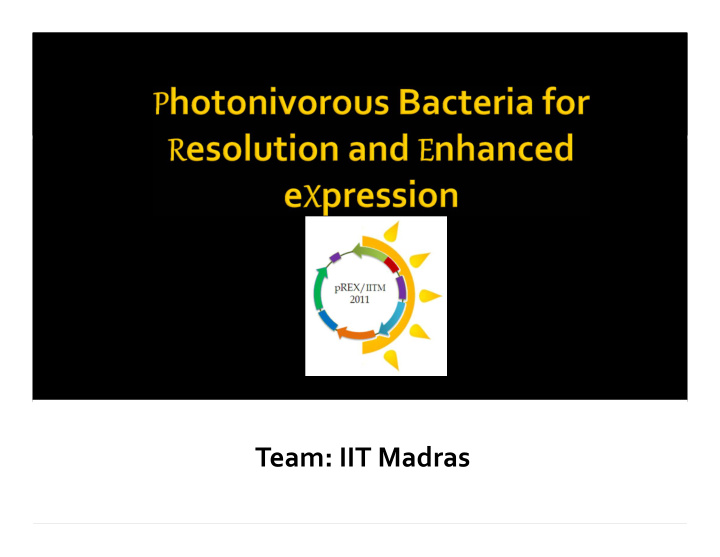



Team: IIT Madras
440000 new cases of Multiple Drug Resistant Tuberculosis
Overuse of Antibiotics Cattle/Poultry Feed Prescriptions Antibiotic resistance genes in research RIP RIP
Selects for Selection against transformants non ‐ transformants • Metabolic Selection Markers • Antibiotic Resistance Genes • Risk of Horizontal Gene Transfer
Project Sunscreen
H+ H+ H+ H+ H+ P P P R R R ATP Synthase + Retinal Retinal ATP
Project Artemis
H+ H+ H+ H+ ATP Synthase Electron Transport Chain Glycolysis ATP Carbon Source
H+ H+ H+ H+ H+ H+ Recombinant Protein P P P R R R ATP Synthase Electron Transport Chain + Retinal Retinal Glycolysis ATP Carbon Source
Proteorhodopsin Coding Gene BBa_K572005 BBa_K572006 Proteorhodopsin Generator BBa_B0034 BBa_K572005 BBa_B0015 BBa_K572007 Constitutive Proteorhodopsin BBa_B0034 BBa_K572005 BBa_J23119 BBa_B0015 Generator BBa_K572008 IPTG induced Proteorhodopsin T7 Promoter BBa_B0034 BBa_K572005 BBa_B0015 Generator (pET vector)
PRIMER PRIMER OUTPUTS INPUTS TOOL TOOL Primer sequence Protein sequence Tm and GC content Number and positions of Mutations Common primer for mutation sites Range of Tm, %GC and Length closer than 20bp
BBa_B0034 BBa_K572009 BBa_K572009 BBa_B0015 Mouse Beta ‐ Carotene Dioxygenase Generator Dioxygenase Coding Gene BBa_J23119 BBa_B0034 BBa_K572009 BBa_B0015 BBa_K274210: Endogenous CrtEBIY synthesis of beta ‐ carotene BBa_K572009 : Retinal Mouse Beta Carotene Biosynthesis Dioxygenase converts beta carotene to Trans ‐ Retinal Retinal with PR in presence of light helps in development of proton gradient β‐ Diox
K572005 K572005 Functional Studies ‐ AzideTest Over Expression of GPR in DH5 α 1 . . Relative number of 0.8 Azide Negative 0.6 CFUs Samples 0.4 Azide Treated 0.2 Samples 28kDA 0 IPTG+ IPTG+ Light ‐ Light+ Time after induction 15% SDS PAGE gel showing the IPTG induction of PR expression
Backbone of pSB1C3, without Chloramphenicol Resistance Gene E X S P BBa_K572100 BBa_K572005 Proteorhodopsin
Hypothesis: Increase in growth rate due to Proteorhodopsin proton efflux in minimal carbon media • Quantification of Proton flux through proteorhodopsin • E.coli genome scale model extended to include proteorhodopsin SBML* • Constraint based Reconstruction and Analysis • Objective function optimization (Flux) COBRA • Simulations to validate network using experimental data Model • Comparative analysis of increase in growth rate in proteorhodopsin transformed cells Analysis *Adam M Feist et al 2007, A genome ‐ scale metabolic reconstruction for Escherichia coli K ‐ 12 MG1655 that accounts for 1260 ORFs and thermodynamic information, Molecular Systems Biology ** Walter et al 2006, “Light empowering Escherichia coli with proteorhodpsin”, PNAS
Simulation of published experimental data for model validation Jessica M. Walter et al 2006, Light ‐ powering Escherichia coli with proteorhodopsin , PNAS) “Light ‐ driven pumping by PR can fully replace respiration as a cellular energy source in some environmental conditions” 70% Inhibition of ETC in Complete Inhibition of ETC in presence of azide presence of azide % Increase In growth rate % Increase in growth rate 120 30 100 25 80 20 60 15 40 10 20 0 5 0 5 10 15 0 0 5 10 15 Glucose uptake flux (in mmol/ g ‐ dw hr) Glucose uptake flux (in mmol/g ‐ dw hr)
Comparative analysis of increase in growth rate in proteorhodopsin transformed cells Growth rate advantage due to PR % Increase in growth rate 35 30 25 20 15 10 5 0 0 5 10 15 Glucose uptake flux ( in mmol/g ‐ dw hr)
Control Growth Profiles (DH5 α ) Comparison of rate of change of specific growth rate in LB 2.5 3 Cell concentration (g/l) 2 Specific growth rate (Hour ‐ 1) 2.5 LB 2 1.5 0.2 g/l 1.5 0.4 g/l 1 1 1 g/l 0.5 0.5 3 g/l 0 0 2 4 6 8 5 g/l 0 time(hour) 0 2 4 6 8 10 Time (Hour) IPTG Induced PR+pET41a in LB PR+pET41a Control in LB Comparison of specific growth rate in M9 media Specific Growth rate (Hour ‐ 1) 3 y = 9.1994e ‐ 0.711x 2 R² = 0.9836 y = 4.2768e ‐ 0.551x 1 R² = 0.9881 0 0 2 4 6 8 Time (Hour) IPTG Induced5g/l M9 media 5g/l M9 media Control
Absorption Spectrum GPR RFP BBa_K118011 BBa_K081014/mRFP1 (PcstA) gen Carbon Stress Induced Promoter BBa_K572001 : Carbon Stress 525 nm 584 nm Response Indicator Wavelength Substrate Availability Bba_K572001 Time
Growth Profile RFP Expression 10 9 700 8 600 7 0 0 500 RLU/OD600 6 OD600 0.02 0.02 400 5 0.1 300 0.1 4 200 0.5 3 0.5 2 100 LB LB 1 0 LB+0.2 LB+0.2 0 0 2 4 6 8 0 2 4 6 8 10 Time (Hours) Time (Hours) As viewed under a fluorescence microscope, RFP being expressed in DH5 α with PcstA promoter
pSB1Pe – Expression Vector Backbone of pSB1C3, without E Chloramphenicol Resistance Gene X S PcstA P BBa_K572200 BBa_K572005 Proteorhodopsin
Kwang ‐ Hwan "Kevin" Jung , Ph.D., Associate Professor, Department of Life Science and Institute of Biological Interfaces, Sogang University, Korea for sending us the plasmid (pKJ900) with proteorhodopsin gene. Prof. Karthik Raman of IIT Madras who helped our team in efficient modelling of our Project Mr. Shrikumar Suryanarayan , Adjunct Professor, IITM, for his financial assistance and encouragement Prof. K B Ramachandran and Prof. Mukesh Doble , Department of Biotechnology IIT Madras for their constant support and encouragement IITM and IITMAA(IITM Alumini Association) for their financial support
Recommend
More recommend